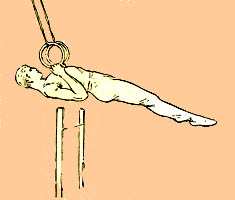 |
Climbing and Gymnastics A Historical Association |
 |
Climbing and Gymnastics A Historical Association |
| Mast
Climbing . . . From GutsMuth's Gymnastik fur die Jugend (1793): "The climbing of the mast is far more challenging [than pole climbing], for the surface is smooth and the hands cannot go around it. Here, it is most necessary to have performed well on elementary exercises [gripping with legs and thighs]. This activity is known, by the way, in several areas of Germany and Europe as an amusement for the general public. A few weeks ago one of my pupils climbed a tree trunk 50 feet high. With nonchalance, he held on to the tree with one hand, tore off some leaves and flowers with the other, and fearlessly scattered them, looking down on his ascent. On such tree trunks one must not climb too high because of vertigo; if one loses his composure, he can slide down the tree, rather than fall." The origins of mast climbing are, of course, obvious in a time of great sailing ships, and it comes as no surprise that it became a recreational as well as functional exercise. Today, lumberjack contests - in which competitiors scale a towering and denuded tree, using special equipment, echo those distant times, and mast climbing usually refers to ascending radio and television masts with safety gear in order to make repairs. Modern masts have climbing rungs or steps, which is ceratinly cheating! |
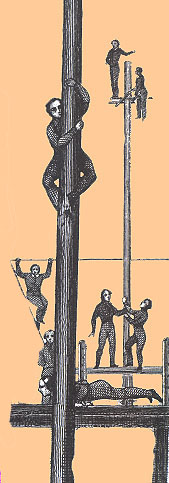 Recreational Mast Climbing, ca. 1830 |
Pole Climbing . . . 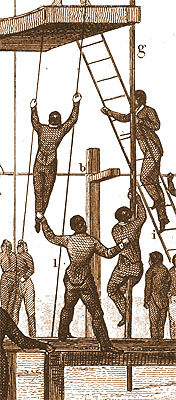 Solid
wooden poles were a standard climbing apparatus whose origin predates
both GutsMuths and Jahn. Poles were used in the middle ages in
acrobatic routines - indeed, they still are used in acts from circuses
like Cirque Du Soleil,
where small performers with fairly short legs simply walk up poles like
monkeys. The difference between a mast
and a pole,
of course, is that one can get a hand firmly around a pole and climb it
like one would climb a rope, whereas a mast must be gripped and
squeezed with the body. Climbing and cavorting about on parallel poles
was popular, as well. Solid
wooden poles were a standard climbing apparatus whose origin predates
both GutsMuths and Jahn. Poles were used in the middle ages in
acrobatic routines - indeed, they still are used in acts from circuses
like Cirque Du Soleil,
where small performers with fairly short legs simply walk up poles like
monkeys. The difference between a mast
and a pole,
of course, is that one can get a hand firmly around a pole and climb it
like one would climb a rope, whereas a mast must be gripped and
squeezed with the body. Climbing and cavorting about on parallel poles
was popular, as well. 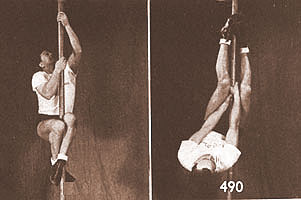 ca. 1830 Germany & Navy Pole Climbers 1940s |
Ropes in Gymnastics . . . 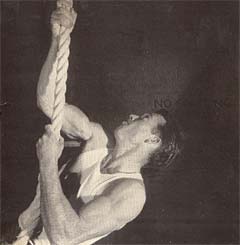 1826 rope or pole climber
&
Garvin Smith in the 1950s
The oblique rope was popularized by Hjalmar Ling and his followers. The equipment listed for a Higher School for Boys in Stockholm around 1900 includes a heavy climbing component: 60 sections of stall bars, 7 Swedish horizontal bars, 2 vertical Swedish ladders, 2 horizontal ones, 8 rope ladders, 24 climbing ropes, 8 poles, 2 double inclined ropes, stallbars extending to high ceiling (vertical ropes meet the inclined ropes at their high points) - A Guide to the History of Physical Education, F. E. Leonard, 1927. The photo of the Stockholm C. I. on page 1.3 shows students exercising on these apparatus. Another section of this website goes into greater detail regarding a former gymnastic event: Competitive Rope Climbing Instruction on Rope Climbing in the 18th Century: From Gymnastik fur die Jugend
(1793): "This
exercise is more aggressive than the previous [ladders], for there
are no steps for the feet; but all lads who can climb
the pole easily find the rope very similar. The only difficulty is
grasping the rope with the feet for a firm support. Knees and thights
are not useful. By sitting in a chair and clasping the feet about
the knuckles, one sees how to pinch the rope with the feet. The feet
grip the rope between them and hold while the hands move further up
the rope, then grasping the rope and moving the feet up. Nothing more
need be known . . ."
And then, on to more demanding challenges: "We introduce the problem of climbing the rope through the power of the hands and arms alone, without using the feet. The exercise is hard, but the gymnast no doubt knows how to approach it; for it is reminiscent of the warm-up in which a healthy, fairly strong person can support his weight with one hand without great effort. It comes with trying. They fail at first - each individual hand, especially the left, is too powerless to pull the body up high enough so that the right hand can grasp the rope even higher. But the gymnast supposes at the start that pressing down on the under-hand makes it easier to grasp the rope higher with the other hand. It requires the practice of suspending one's self with one hand, especially the left hand. After considerable practice the goal is reached, and the effect lasts many months." GutsMuth continues: ". . . We've climbed high, the hands lose power. Then what? Should we climb down or fall down? We may not be able to go either up or down. What should we now do? We must hold on until we recover. Good, but how, without using the power of the hands? Each student must reflect upon that and discover how to wrap the rope around themselves so that they may be held comfortably by it. The student presses himself to make the attempt, and after several tries he solves the problem: he climbs to a moderate height. Here he stops. He wraps the rope, using one foot, twice to four times around the other foot, then squeezes the twisted rope together firmly between both feet. The friction between the rope and feet supports the body's entire weight." (Illustrations on previous pages show this technique clearly) Finally: "I know some who climb up and down, very lightly. This feat is one of the prettiest and most appropriate for strengthening all the muscles of the breast and arms and hands - it is a true 'touch-stone' of the powers of these members and indicates the increase of these in a very certain manner" |
A Description of Gymnastic Facilities at Harvard, circa 1826 . . . The new Gymnastics Room at Harvard was designed by an architect of the Round Hill facility. "We began with a large room, fitted with parallel and horizontal bars, ladders, climbing poles, wooden horses, dumb-bells and the like". An outdoors exercise area was subsequently created, in which, ". . . there was an upright mast, about 70 feet high, stayed with guys, which ran from the top of the mast in opposite directions to the ground, at an angle of about 30 degrees. Half-way up the mast was a platform, from which large beams ran out on either side, at right angles, supported at each end by strong posts. To this platform one could ascend by a ladder, but from the platform to the top he must climb the bare mast, aided only by a knotted rope" - J. F. Clarke, Autobiography(1888). 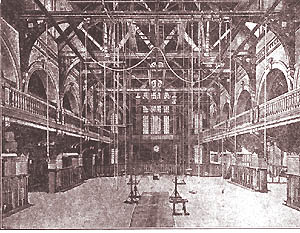 Within ten years the Harvard Gymnasium had
closed. Some correspondance from the time indicates the
exercises might have been too severe - the apparatus too demanding -
and that physical educators moved to
other venues. Another possibility is that gymnastics in America was
merely another fad, with interest waning quickly. Others point out that
American students lacked perserverance, unlike their German
counterparts. Within ten years the Harvard Gymnasium had
closed. Some correspondance from the time indicates the
exercises might have been too severe - the apparatus too demanding -
and that physical educators moved to
other venues. Another possibility is that gymnastics in America was
merely another fad, with interest waning quickly. Others point out that
American students lacked perserverance, unlike their German
counterparts. A later Harvard gym: Hemenway Gymnasium, 1885 |
Dynamic
Motion . . . 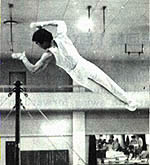 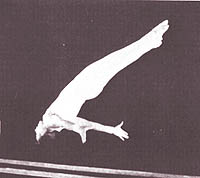 Dynamics:
In the late 1700s and early 1800s, F. Jahn and
others devised several pieces of apparatus that form the basis of
modern gymnastics. The horizontal
bar, parallel bars,
(and still rings
-1842) were added to the ancient pommel
or side horse, whose
origins - military in nature - go back at least two thousand years.
Swinging moves on the new apparatus appeared quickly. Years later free-aerial moves
or releases
in which the athlete is separated from the apparatus momentarily, would
become part of the repertoire of the average competitive gymnast. Dynamics:
In the late 1700s and early 1800s, F. Jahn and
others devised several pieces of apparatus that form the basis of
modern gymnastics. The horizontal
bar, parallel bars,
(and still rings
-1842) were added to the ancient pommel
or side horse, whose
origins - military in nature - go back at least two thousand years.
Swinging moves on the new apparatus appeared quickly. Years later free-aerial moves
or releases
in which the athlete is separated from the apparatus momentarily, would
become part of the repertoire of the average competitive gymnast. 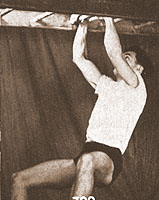 Dynamic motion on ladders and ropes evolved as ladder-climbers , ascending the underside, began hopping from one rung to another, and rope-climbers began to use the momentum of an initial hard and fast pull to propel them rapidly up the rope. Strongmen, following in the footsteps of the great Sandow in the late 1800s, could jump from one rung to the other with facility. "Modern" rope climbers during the period 1896-1963 developed momentum to trim the recorded time for competition rope climbs from 7.0 seconds (8 meters) in 1904 to 4.5 seconds (25 feet) in 1947 - and a remarkable 2.8 seconds (20 feet) in 1953. Navy
gymnast jumping rungs on a horizontal ladder ca. 1942
|
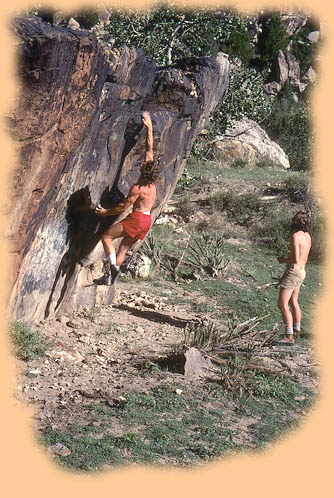 Young John Long, mid 1970s Southern Colorado |
Dynos . . .
Controlled free-aerial moves - as opposed to desperate lunges - from one set of holds to another on overhanging rock first appeared in America in the late 1950s and early 1960s. Earlier, Pierre Allain and his companions sometimes added a jump start to a problem. Other dynamic activities, prior to 1960, included doing moves on rock with one arm on rare occasions. On some of the harder boulder routes these days, climbers use short dynamic reaches to move from one microscopic handhold to another - "popping" from hold to hold. Generations of young climbers have pushed dynamic motion on the rock to spectacular levels |
Early Women's Gymnastics . . . "Women were popular gymnastic dancers and their movements were performed to music, like the modern floor exercises. One famous woman was Matilda Makejoy, who was in and out of royal service for fourteen years. She performed in 1306 when England's King Edward I celebrated the knighting of his son with a feast for 300 nobles" - The Illustrated History of Gymnastics by John Goodbody (1982). Here's the earliest illustration I can find of a girl on "modern" apparatus. It's from a handbook on exercises for young ladies. Although women had performed as "gymnastic" dancers and balancers for centuries, they were rarely instructed in such exercises for the sake of health and well-being. With the introduction of formal gymnastic apparatus came several efforts to encourage girls and women to participate in this new sport : 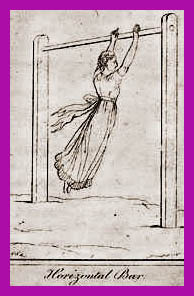 "You know the
prevailing notions of female delicacy and propriety are
at variance with every attempt to render females less feeble and
helpless . . . But the beneficial effects of what I had already
introduced led me to persevere, and I have finally succeeded in
contriving apparatus and exercises enough to
keep all employed . . . Besides the ordinary exercises of raising the
arms and feet, and extending them in various
directions, we have various methods of hanging and swinging
by the arms . . ." - William
Fowle, a teacher at Monitorial School, Boston, in a letter
to Dr. John Coffin via the Medical
Intelligencer, 1825
"You know the
prevailing notions of female delicacy and propriety are
at variance with every attempt to render females less feeble and
helpless . . . But the beneficial effects of what I had already
introduced led me to persevere, and I have finally succeeded in
contriving apparatus and exercises enough to
keep all employed . . . Besides the ordinary exercises of raising the
arms and feet, and extending them in various
directions, we have various methods of hanging and swinging
by the arms . . ." - William
Fowle, a teacher at Monitorial School, Boston, in a letter
to Dr. John Coffin via the Medical
Intelligencer, 1825 "We value this letter mainly . . . because it is the first account we have seen of gymnastics having been successfully practised in any school for girls, in any part of the United States . . ." - Editorial reply by Dr. Coffin 1827 |
| Here
are two
(or one) female gymnasts in appropriate costume from Dr. Dio Lewis' New Gymnastics for Men, Women, and
Children , 1862. Music: "Exercises with the upper extremities are as much improved by music as those with the lower extremities . . . A small drum, costing perhaps $5, which may be used as a bass drum, with one beating stick, with which anyone may keep time, is, I suppose, the sort of music most classes in gymnastics will use at first . . . The violin and piano are excellent, but on some accounts the hand organ is best of all . . . Feeble and apathetic people, who have little courage to undertake gymnastic training, accomplish wonders under the inspiration of music. I believe five times as much muscle can be coaxed out, under this delightful stimulus, as without it." (From New Gymnastics . . . ) (My mother played the piano for women's gym classes at the University of Texas in the late 1940s) |
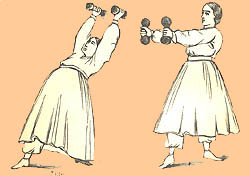 |
By the late 1800s, however, the natural gymnastic and climbing abilities of women were recognized by physical educators and gymnasium architects. It is clear that by this time expectations for the ladies were quite high. 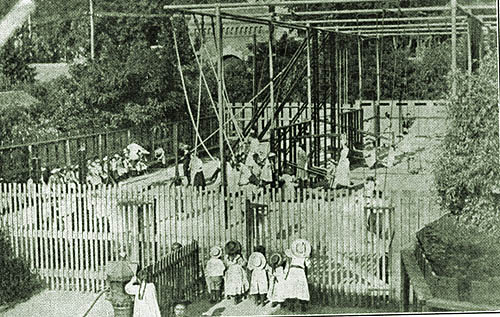 The Charlesbank Women's Gymnasium
in Boston, 1889. The equipment included: two pole ladders, two perpendicular
ladders, four hanging ropes (fastened at the bottom), one long inclined
rope and attachments, four long and four short inclined poles, four
perpendicular ladders combined, five serpentine ladders
united, two perpendicular climbing poles, twelve swinging ropes,
one horizontal rope ladder, two sets of flying rings. The Charlesbank Women's Gymnasium
in Boston, 1889. The equipment included: two pole ladders, two perpendicular
ladders, four hanging ropes (fastened at the bottom), one long inclined
rope and attachments, four long and four short inclined poles, four
perpendicular ladders combined, five serpentine ladders
united, two perpendicular climbing poles, twelve swinging ropes,
one horizontal rope ladder, two sets of flying rings.
|
Eventually, gymnastic climbing activities for women would fade away, except as preparation for a circus career . . . as they would for men . . . but return as indoor wall climbing in the last quarter of the 20th century. 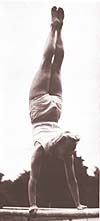 An
interesting factoid: it is not generally known these days, but until
1952 women's
competition included men's
parallel bars, as opposed to the uneven bars used today. By
adopting the uneven bars, women could perform both on the bars and, in
a sense, on the high bar - avoiding direct competition with men. An
interesting factoid: it is not generally known these days, but until
1952 women's
competition included men's
parallel bars, as opposed to the uneven bars used today. By
adopting the uneven bars, women could perform both on the bars and, in
a sense, on the high bar - avoiding direct competition with men. Pat Hirst, British Women's' Champion 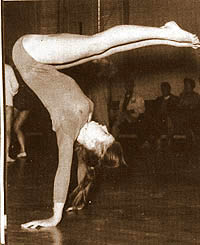 By 1954 Women's Gymnastics
had been standardized and the Soviets and Eastern Europeans led the
way. My initial exposure to this aspect of the sport was at the
1959 Pan Am Games in Chicago. There I saw a youthful, vibrant Muriel Davis (later Grossfeld)
perform. I still recall, in amazement, watching her do a straight arm,
straight leg press to handstand on the balance beam. This caused me to
revise my opinion on the future of women in climbing! I thought to
myself: Look out guys . . . By 1954 Women's Gymnastics
had been standardized and the Soviets and Eastern Europeans led the
way. My initial exposure to this aspect of the sport was at the
1959 Pan Am Games in Chicago. There I saw a youthful, vibrant Muriel Davis (later Grossfeld)
perform. I still recall, in amazement, watching her do a straight arm,
straight leg press to handstand on the balance beam. This caused me to
revise my opinion on the future of women in climbing! I thought to
myself: Look out guys . . . Muriel Davis Grossfeld later became the coach of the USA Women's Olympic Squad. Muriel Davis in 1956 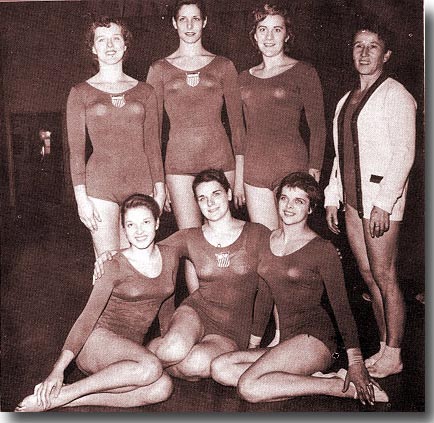 What of the current state of women's
gymnastics? Here
is a photo of the 1956 USA
Women's Squad. Observe that the team
members are indeed women. What of the current state of women's
gymnastics? Here
is a photo of the 1956 USA
Women's Squad. Observe that the team
members are indeed women. In its contemporary incarnation, it seems more appropriate to call the international sport Girl's Gymnastics, the price paid for an unwavering, intense, and unforgiving focus on difficult stunts, rather than easier routines judged more on grace of performance. That's just my opinion - there are many, many supporters of the diminutive sprites, and I'll admit, they're fun to watch as they spin and twirl through the air! A few of these youngsters have become leading rock climbers and boulderers . . . Fortunately, college gymnastics in America offers an appealing venue for slightly more mature young women. |